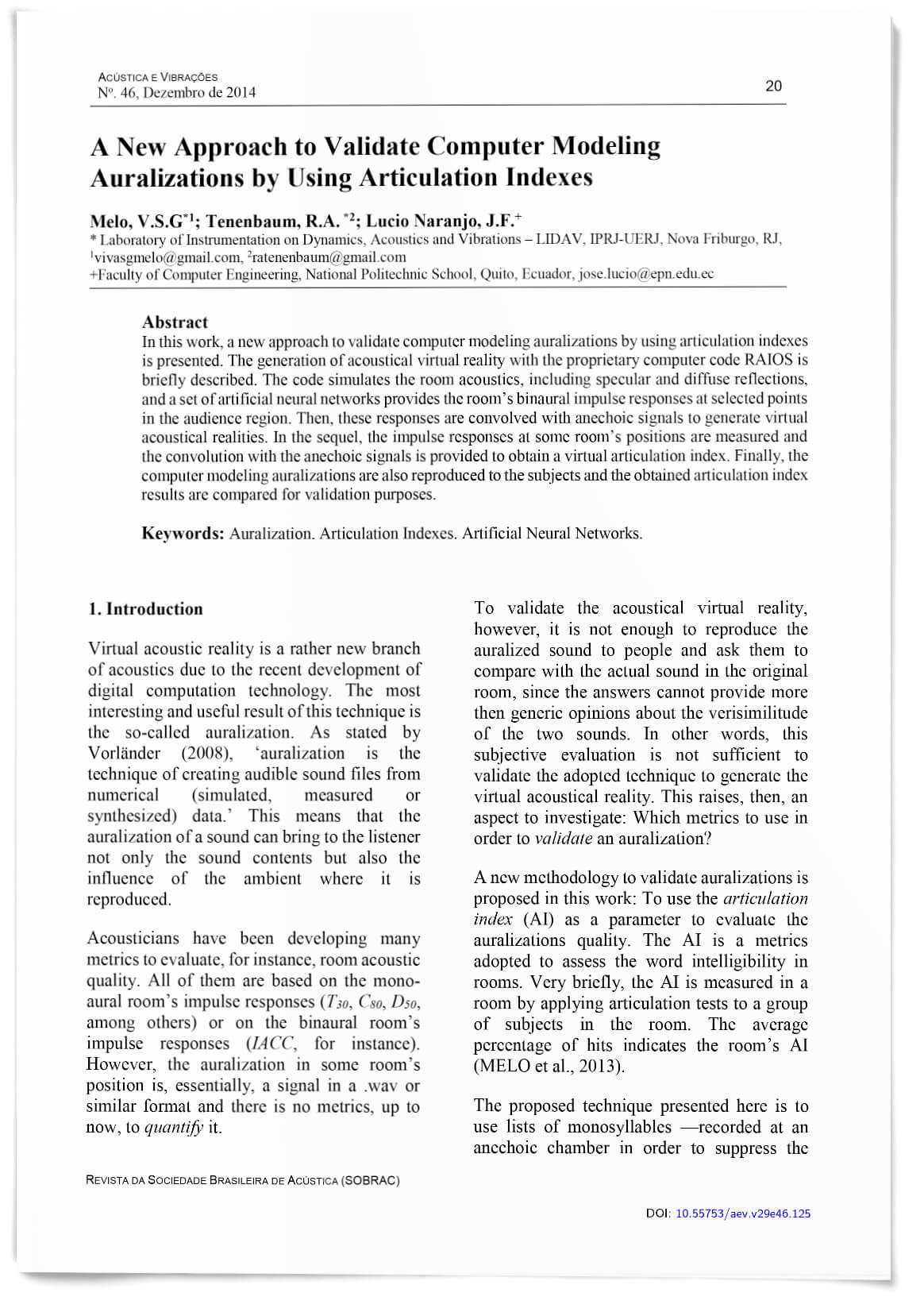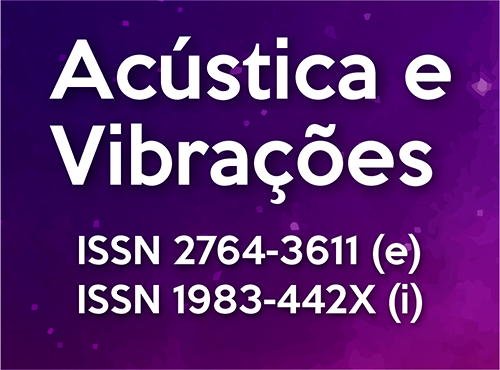A New Approach to Validate Computer Modeling Auralizations by Using Articulation Indexes
DOI:
https://doi.org/10.55753/aev.v29e46.125Keywords:
auralization, articulation indexes, artificial neural networksAbstract
In this work, a new approach to validate computer modeling auralizations by using articulation indexes is presented. The generation of acoustical virtual reality with the proprietary computer code RAIOS is briefly described. The code simulates the room acoustics, including specular and diffuse reflections, and a set of artificial neural networks provides the room’s binaural impulse responses at selected points in the audience region. Then, these responses are convolved with anechoic signals to generate virtual acoustical realities. In the sequel, the impulse responses at some room’s positions are measured and the convolution with the anechoic signals is provided to obtain a virtual articulation index. Finally, the computer modeling auralizations are also reproduced to the subjects and the obtained articulation index results are compared for validation purposes.
References
AJDLER, T., FALLER, C., SBAIZ, L. AND VETTERLI, M., 2005. Sound Field Analysis along a Circle and Its Applications to HRTF Interpolation. J. Audio Eng. Soc., Vol. 56(3), 156–175.
BERANEK, L. 1996. Concert and Opera Halls: How They Sound. Acoustical Society of America, Woodbury. doi:10.1063/1.881889 DOI: https://doi.org/10.1121/1.414882
BLAUERT, J., 1997. Spatial Hearing. The MIT Press, Cambridge. doi: 10.7551/mitpress/6391.001.0001 DOI: https://doi.org/10.7551/mitpress/6391.001.0001
BORK, I. 2005. Report on the 3rd Round Robin on room acoustics computer simulation – Part 2: Calculations. Acustica united with Acta Acustica, Vol. 91(4), 753–763.
CAMILO, T.S. AND TENENBAUM, R.A. 2002. Método híbrido para simulação numérica e acústica de salas - Parte 1: combinação dos métodos de traçado de raios e de transição de energia. XX Encontro da Sociedade Brasileira de Acústica, Rio de Janeiro. (In Portuguese).
DALEMBÄCK, B.I., KLEINER, M. AND SVENSSON, P. 1994. A macroscopic view of the diffuse reflection. J. Audio Engin. Soc., Vol. 42(10), 973–987.
GARDNER, B., MARTIN, K., 1995. HRTF Measurements of a KEMAR Dummy-Head Microphone. J. Acoust. Soc. Am., Vol. 97(6), 3907–3908. DOI: https://doi.org/10.1121/1.412407
HAYKIN, S., 2009. Neural Networks and Learning Machines. Prentice Hall, New Jersey.
ISO 3382, 1997. Acoustics – Measurement of the reverberation time of rooms with reference to other acoustical parameters.
KRUZINS, E., FRICKE, F.R., 1982. The prediction of sound fields in non-diffuse spaces by a ‘random walk’ approach. J. Sound and Vib., Vol. 81(4),549–564. doi: 10.1016/0022-460X(82)90296-6 DOI: https://doi.org/10.1016/0022-460X(82)90296-6
LUCIO NARANJO, J.F.L., TENENBAUM, R.A. AND TORRES, J.C.B., 2010. Using Artificial Neural Networks to generate virtual acoustic reality applied on escape training in blind conditions Int. Rev. CHem. Eng., Vol. 2(6), 754–759.
LUCIO NARANJO, J.F.L., TENENBAUM, R.A., TORRES, J.C.B., 2013. Accuracy validation of the ANN’s interpolation technique through the use of acoustic quality parameters. XVI Computer Modeling Meeting, Ilhéus.
MELO, V.S.G., TENENBAUM, R.A. AND MUSAFIR, R.E., 2013. Intelligibility assessment in elementar school classrooms from binaural room impulse responses measured with a childlike dummy head. Applied Acoustics, Vol. 74, 1436–1447. doi: 10.1016/j.apacoust.2013.06.005 DOI: https://doi.org/10.1016/j.apacoust.2013.06.005
MÜLLER, S. & MASSARANI, P.M., 2001. Transfer-functions measurements with sweeps. J. Audio Eng. Soc., Vol. 2001, 443–471.
TENENBAUM, R.A., CAMILO, T.S., TORRES J.C.B. AND GERGES, S.N.Y., 2007a. Hybrid method for numerical simulation of room acoustics with auralization: Part 1 - Theoretical and numerical aspects. J. Brazilian Soc. Mech. Sci. Engin., Vol. 29(2), 211–221. doi: 10.1590/S1678-58782007000200012 DOI: https://doi.org/10.1590/S1678-58782007000200012
TENENBAUM, R.A., CAMILO, T.S., TORRES J.C.B. AND STUTZ, L.T., 2007b Hybrid method for numerical simulation of room acoustics: Part 2 - Validation of the computational code RAIOS 3. J. Brazilian Soc. Mech. Sci. Engin., Vol. 29(2), 222–231. doi: 10.1590/S1678-58782007000200013 DOI: https://doi.org/10.1590/S1678-58782007000200013
TORRES, J.C.B., PETRAGLIA, M.R., AND TENENBAUM, R.A., 2004. An Efficient wavelet-based HRTF for auralization Acta Acustica United with Acustica, Vol. 90(1), 108–120.
VORLÄNDER, M., 2008. Auralization: Fundamentals of Acoustics, Modeling, Simulation, Algorithms and Acoustic Virtual Reality Springer, Berlin. doi: 10.1121/1.2908264 DOI: https://doi.org/10.1121/1.2908264
WERSNYI, G., 2009. Effect of emulated head-tracking for reducing localization errors in virtual áudio simulation IEEE Transactions On Audio, Speech, And Language Processing, Vol. 17, n. 2, pp. 247–252. doi: 10.1109/TASL.2008.2006720 DOI: https://doi.org/10.1109/TASL.2008.2006720

Published
How to Cite
Issue
Section
License
Copyright (c) 2014 Acústica e Vibrações

This work is licensed under a Creative Commons Attribution-NonCommercial-ShareAlike 4.0 International License.




